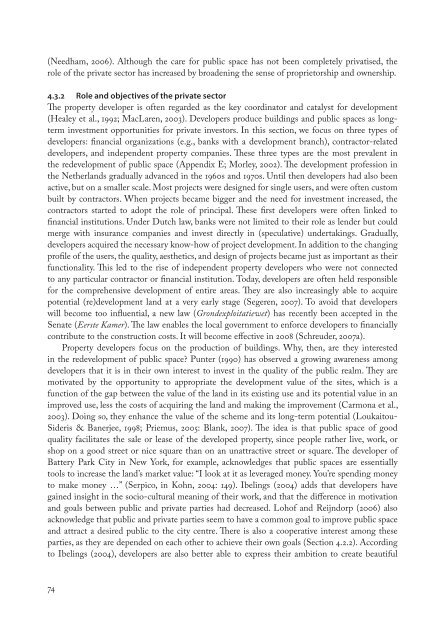Changing public space
Changing public space
Changing public space
Create successful ePaper yourself
Turn your PDF publications into a flip-book with our unique Google optimized e-Paper software.
(Needham, 2006). Although the care for <strong>public</strong> <strong>space</strong> has not been completely privatised, the<br />
role of the private sector has increased by broadening the sense of proprietorship and ownership.<br />
4.3.2 Role and objectives of the private sector<br />
The property developer is often regarded as the key coordinator and catalyst for development<br />
(Healey et al., 1992; MacLaren, 2003). Developers produce buildings and <strong>public</strong> <strong>space</strong>s as longterm<br />
investment opportunities for private investors. In this section, we focus on three types of<br />
developers: financial organizations (e.g., banks with a development branch), contractor-related<br />
developers, and independent property companies. These three types are the most prevalent in<br />
the redevelopment of <strong>public</strong> <strong>space</strong> (Appendix E; Morley, 2002). The development profession in<br />
the Netherlands gradually advanced in the 1960s and 1970s. Until then developers had also been<br />
active, but on a smaller scale. Most projects were designed for single users, and were often custom<br />
built by contractors. When projects became bigger and the need for investment increased, the<br />
contractors started to adopt the role of principal. These first developers were often linked to<br />
financial institutions. Under Dutch law, banks were not limited to their role as lender but could<br />
merge with insurance companies and invest directly in (speculative) undertakings. Gradually,<br />
developers acquired the necessary know-how of project development. In addition to the changing<br />
profile of the users, the quality, aesthetics, and design of projects became just as important as their<br />
functionality. This led to the rise of independent property developers who were not connected<br />
to any particular contractor or financial institution. Today, developers are often held responsible<br />
for the comprehensive development of entire areas. They are also increasingly able to acquire<br />
potential (re)development land at a very early stage (Segeren, 2007). To avoid that developers<br />
will become too influential, a new law (Grondexploitatiewet) has recently been accepted in the<br />
Senate (Eerste Kamer). The law enables the local government to enforce developers to financially<br />
contribute to the construction costs. It will become effective in 2008 (Schreuder, 2007a).<br />
Property developers focus on the production of buildings. Why, then, are they interested<br />
in the redevelopment of <strong>public</strong> <strong>space</strong>? Punter (1990) has observed a growing awareness among<br />
developers that it is in their own interest to invest in the quality of the <strong>public</strong> realm. They are<br />
motivated by the opportunity to appropriate the development value of the sites, which is a<br />
function of the gap between the value of the land in its existing use and its potential value in an<br />
improved use, less the costs of acquiring the land and making the improvement (Carmona et al.,<br />
2003). Doing so, they enhance the value of the scheme and its long-term potential (Loukaitou-<br />
Sideris & Banerjee, 1998; Priemus, 2005: Blank, 2007). The idea is that <strong>public</strong> <strong>space</strong> of good<br />
quality facilitates the sale or lease of the developed property, since people rather live, work, or<br />
shop on a good street or nice square than on an unattractive street or square. The developer of<br />
Battery Park City in New York, for example, acknowledges that <strong>public</strong> <strong>space</strong>s are essentially<br />
tools to increase the land’s market value: “I look at it as leveraged money. You’re spending money<br />
to make money …” (Serpico, in Kohn, 2004: 149). Ibelings (2004) adds that developers have<br />
gained insight in the socio-cultural meaning of their work, and that the difference in motivation<br />
and goals between <strong>public</strong> and private parties had decreased. Lohof and Reijndorp (2006) also<br />
acknowledge that <strong>public</strong> and private parties seem to have a common goal to improve <strong>public</strong> <strong>space</strong><br />
and attract a desired <strong>public</strong> to the city centre. There is also a cooperative interest among these<br />
parties, as they are depended on each other to achieve their own goals (Section 4.2.2). According<br />
to Ibelings (2004), developers are also better able to express their ambition to create beautiful<br />
74




